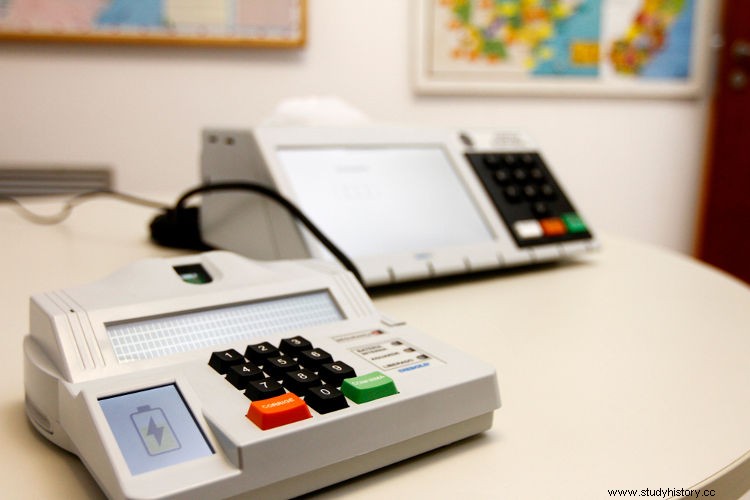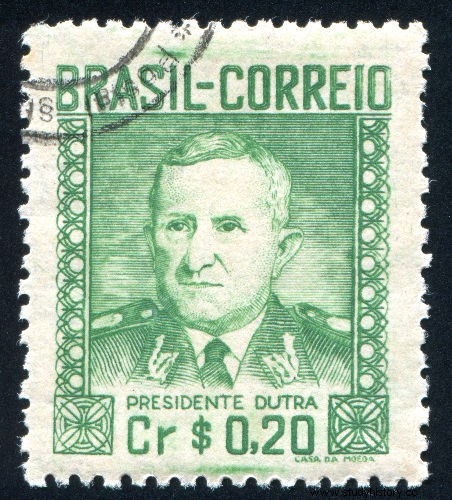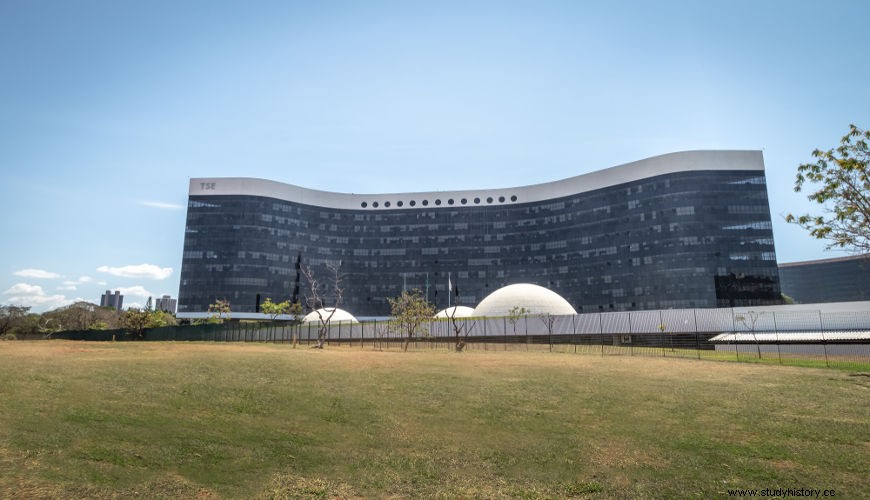
The history of elections in Brazil began there in the colonial period when an election was held for the first time in the country, in 1532. Since then, the right to vote in Brazil has undergone profound transformations, as has the country's political system. The current system was designed at the end of the Military Dictatorship and has been in force since the promulgation of the 1988 Constitution.
Abstract
The first election held in Brazil took place in 1532, in the Captaincy of São Vicente, and it was carried out for the choice of representatives of the Municipal Councils. In the monarchic phase, the electoral system was indirect, and the right to vote was restricted by the voter's income. This indirect system was used to choose deputies.
At the end of the monarchy, a reform was carried out, resulting in the decrease of the Brazilian electorate, limiting the right to vote to a small elite portion of Brazilian society. In the First Republic, the right to vote was extended to men over 21 and literate, and elections in this period were marked by fraud.
Between 1945 and 1964, Brazil had a democratic experience in which the population was able to choose presidents in four elections. This period, however, was interrupted by the 1964 coup, and Brazilian voters could only vote for president in 1989, when the Brazilian electoral system was reformulated with the 1988 Constitution, which initiated a new democratic phase in Brazil.
Voting history in Brazil
Voting in Brazil is a practice established since the colonial period. Every three years, elections were held in several villages to determine the choice of people who would occupy the positions of the Chamber Municipal for the following years.
The implementation of elections in Brazil, naturally, happened from the Portuguese, who used this system in Portugal. The first known election in Brazil took place in 1532, in the Captaincy of São Vicente, and followed the determinations of the Ordinances of the Kingdom , compilations of laws made by the kings of Portugal.
The right to vote, however, was limited to good men , a group of men who had some noble lineage or who carried out some type of important economic activity. The electoral process that took place in the villages built in Brazil during the colonial period was indirect. Thus, voters chose voters who would determine the choice of names that would ultimately be chosen by lot. At the end of the electoral process, judges, councilors and prosecutors were chosen who would exercise this function for three years.
From 1822, Brazil became an independent nation, with the monarchy as a form of government (D. Pedro I and D. Pedro II were the emperors). In this period of Brazilian history, the functioning of the electoral system was determined by the Constitution of 1824 , granted by D. Pedro I.
The Brazilian electoral system determined that the vote was census , that is, a criterion was imposed to determine who would have the right to vote. Thus, in Brazil, only free men, over 25 years old and with a minimum annual income of 100 thousand réis could vote . The electoral system of the monarchic period was also indirect and functioned briefly as follows:
-
Those who had the minimum voting conditions, the voters da province , elected compromising voters;
-
These, in turn, elected the parish voters;
-
The parish voters elected the voters da region;
-
Finally, the district voters elected the deputies .
In the case of senators, the three with the most votes were taken to the Emperor, who nominated one of them.
During the Empire, freedmen had the right to vote only in the basic instance, that is, as voters of the province. Illiterates had the right to vote until an electoral reform that took place in 1881 and became known as the Law Hail .
The Saraiva Law brought major changes in the way Brazilian elections functioned, instituting direct voting, which was a very big demand at that time. In addition, it doubled the income requirement for the citizen to have the right to vote and, thus, the amount of 200 thousand réis is now required as a minimum annual income. .
The Saraiva Law also began to require voters who signed up to vote to sign a document as a guarantee. This requirement obviously deprived the illiterate of the right to vote, since they were unable to sign the document. As a result of all the demands made by the Saraiva Law, the Brazilian electorate was drastically reduced.
The historian José Murilo de Carvalho, for example, claims that, with the Saraiva Law, the Brazilian electorate dropped from 13% of the population to 0.8% . In absolute numbers, the number of voters in Brazil only surpassed what existed before the Saraiva Law with the beginning of the Fourth Republic 1 , in 1945. The law is also understood by historians as a conservative reaction, since at that time abolitionism was gaining strength in society.
With the Proclamation of the Republic, which took place on November 15, 1889, a new Constitution was promulgated, and the functioning of the Brazilian electoral system also underwent changes. Brazil became a Republic, and the political system adopted was presidentialism. The president was elected for a term of four years.
Brazil adopted universal male suffrage for all men over the age of 21, as long as they were not foot soldiers and beggars, and the vote was not secret. This system was in place during the entire period of the First Republic, which was marked by the vote fraud .
The 1930 Revolution put Getúlio Vargas in power and, during his government, in 1932, the Code was created Electoral, who instituted Justice Electoral . This Electoral Code brought considerable changes to Brazil's electoral system. Universal women's suffrage was decreed and the secret ballot was instituted.
From 1945 onwards, Brazil returned to presidential and democratic elections with the beginning of the Fourth Republic. During this period elections took place in 1945 , 1950 , 1955 and 1960 . The 1964 coup interrupted this democratic process in Brazil, and our country only had democratic elections again in 1989. From then on, elections took place in Brazil in 1994 , 1998 , 2002 , 2006 , 2010 , 2014 and 2018 .
Presidential elections in Brazil
Presidential elections in Brazil began with the Proclamation of the Republic, when presidentialism was adopted as a system of government by the Constitution of 1891 . The first election that chose a president in Brazil was an indirect election that took place in 1891 and elected Deodoro da Fonseca as president. The first president to be elected by direct vote was Prudente de Morais, who won the 1894 election.
Also see: See the five-year period in which Brazil was ruled by the military
The period of the First Republic was marked by fraud electoral. Polling zone minutes were manipulated, and voters were coerced or bought. The act of coercing the voter became known as voting from halt and it happened because the vote was not secret. Because of this rigged system, throughout the entire First Republic, only three elections were reasonably contested:that of 1910, 1922 and 1930. The winners of these elections were, respectively, Hermes da Fonseca , Arthur Bernardes and Julius Ready .
With the rise of Vargas to power, Brazil only had presidential elections again in 1945, in the election that inaugurated the period known as the Fourth Republic. This democratic period in our history took place in the midst of two dictatorships (Estado Novo [1937-1945] and Military Dictatorship [1964-1985]).

Eurico Gaspar Dutra was elected president in 1945 and inaugurated the democratic period known as the Fourth Republic.**
Throughout the Fourth Republic, elections took place in the following years:
-
In 1945, Eurico Gaspar Dutra was elected president with 55% of the votes;
-
In 1950, Getúlio Vargas was elected president with 48% of the votes;
-
In 1955, Juscelino Kubitschek was elected president with 36% of the votes;
-
In 1960, Jânio Quadros was elected president with 48% of the votes.
Presidents in the Fourth Republic (1945-1964) were elected for a five-year term. Re-election was not allowed, and the winner was decreed by a simple majority of votes, thus, there was no need to hold a second round. During this period, the population also voted separately for vice president, and this meant that candidates from different slates were elected, as happened in 1960, when Jânio Quadros (UDN) and Jango (PTB) were elected president and vice president, respectively.
Also see: First Phase and Second Phase
With the beginning of the Military Dictatorship, Brazilians lost their right to elect the president. This was made possible by the Institutional Act nº 2 , Art. 9, which stated that the “election for President and Vice-President of the Republic will be carried out by an absolute majority of the members of the National Congress, in public session and nominal vote” 2 .
In 1985, the presidential election continued to be indirect, since the Constitutional Amendment Dante de Oliveira (Emenda das Diretas Já) was defeated in the Chamber of Deputies. In this election, Tancredo Snows was elected president by indirect vote, but died before assuming the presidency. With that, his deputy, Jose Sarney, took over and became president of Brazil.
The current electoral system was established with the Constitution of 1988 and was improved with the Law on Elections , enacted in 1997. In this period of Brazilian history, known as Nova Republic , elections took place in the following years:
-
In 1989, Fernando Collor was elected president in the second round with 53% of the votes;
-
In 1994, Fernando Henrique Cardoso (FHC) was elected president in the first round with 54% of the votes;
-
In 1998, FHC was re-elected president in the first round with 53% of the votes;
-
In 2002, Lula was elected president in the second round with 61% of the votes;
-
In 2006, Lula was re-elected president in the second round with 61% of the votes
-
In 2010, Dilma Rousseff was elected president in the second round with 56% of the votes;
-
In 2014, Dilma Rousseff was re-elected president in the second round with 52% of the votes.
Dilma Rousseff, however, was removed from the presidency of Brazil in 2016 in an impeachment process. There are jurists, historians and intellectuals, however, who understand that Dilma's removal from the presidency was carried out in a controversial way and, thus, characterize this process as a parliamentary coup.
How do elections work in Brazil today?

The Superior Electoral Court (TSE) is the largest legal institution in the Brazilian electoral system and is headquartered in Brasília (DF).***
Brazil's current electoral system operates in accordance with the provisions of the Brazilian Electoral Code , document that brings together the Constitution and several other laws, such as the Law on Elections and the Law on Political Parties.
The presidential election in Brazil takes place every four years and in it voters also vote for Governor , Senator , Deputy Federal , Deputy State and Deputy District (in the case of the Federal District). Elections for Mayor also take place every four years. and Alderman in all cities in Brazil.
In the presidential election, registered candidates compete for the presidency in two stages, known as first and second turn . In order for a candidate to win the first round, he must obtain 50% +1 of valid votes , that is, the majority of votes. Null and blank votes are considered invalid votes and are therefore discarded.
If no candidate achieves an absolute majority of valid votes, the two best placed candidates go to the second round, and the candidate with the most votes wins the election. In the recent history of Brazil, the presidential race in the second round took place in the following years:
-
1989:Collor 53% x 47% Squid
-
2002:Lula :61% x 39% Saw
-
2006:Lula 61% x 39% Alckmin
-
2010:Dilma 56% x 44% Saw
-
2014:Dilma 52% x 48% Aécio
The only president who won his disputes in the first round was Fernando Henrique Cardoso, in 1994 and 1998. This system explained above also applies to the contest for Governor and for Mayor (in the case of Mayor, it only applies to cities with more than 200,000 voters). President, Governor and Mayor can run for one re-election only.
For the election of senator, the election is by simple majority. In the case of the election of deputies and councilors, the election is proportional and depends on the so-called electoral quotient, which determines which parties and which candidates will be elected. The position of senator lasts for eight years, and that of deputy lasts for four years.
Voting in Brazil takes place on the first Sunday of October for the first round and on the last Sunday of October for the second round. Currently, voting in Brazil is a mandatory exercise. for all citizens aged between 18 and 70. For those aged between 16 and 18, over 70 and who are illiterate, voting is not mandatory.
History of elections around the world
The World Election Story , of course, is not uniform. Thus, certain locations adhered to the use of elections quickly, while others adhered to this mechanism late. In the case of many ancient civilizations, the lack of evidence also makes the work of historians difficult.
In any case, in peoples of Antiquity , there were already elections, as in Ancient Greece , particularly in the democratic model that developed in Athens. It is important to point out that the right to vote in Athens, that is, the right to citizenship, was restricted to adult men, born in the city, free and who had military training. This corresponded to up to 20% of Athenian society and therefore excluded women, foreigners (from the Greek point of view, the foreigner was anyone born in another city) and slaves. In Athens , elections were held to determine the choice of people who would occupy positions with a certain technical aptitude, such as military positions.
In addition to the Athenians in Ancient Greece, there are indications of elections being held in other peoples, such as the Romans, Hindus and Celts. Each one had its particularities and purposes.
The current democracy that exists in different parts of the world is known as Representative Democracy and emerged around the 18th century, inspired by movements such as the American Revolution and the French Revolution. Both movements had liberal and Enlightenment ideas as their ideological roots, which advocated that the people have a stake in choosing their representatives.
After the Second World War, representative democracies gained strength in the West, in countries such as the United States, France, England, Sweden, Germany, etc. There are, however, studies carried out by political scientists that point out that democracies and the representative system are in decline in the world and are being replaced by authoritarian and autocratic governments.
Political scientists, such as Steven Levitsky and Daniel Ziblatt, have carried out studies pointing to the weakening of democracy in countries such as Hungary, Poland, Turkey, Venezuela, among others 3 . Freedom House, a non-profit organization in the United States, pointed out that from 2006 to 2016 the rate of “not free” countries increased from 23% to 25% 4 .
_____________________
1
CARVALHO, J. M. Citizenship in Brazil:the long way. Rio de Janeiro:Brazilian Civilization, 2004, pp. 38-40.
2
Institutional Act nº 2. To access, click here.
3
LEVITSKY, Steven and ZIBLATT, Daniel. How democracies die. Rio de Janeiro:Zahar, 2018.
4
Freedom in the world, 2017. To access, click here.
*Image credits:Rodrigo Gavini / Shutterstock
**Image credits:Rook76 / Shutterstock
***Image credits:Diego Grandi / Shutterstock
By Daniel Neves Silva
Graduate in History
